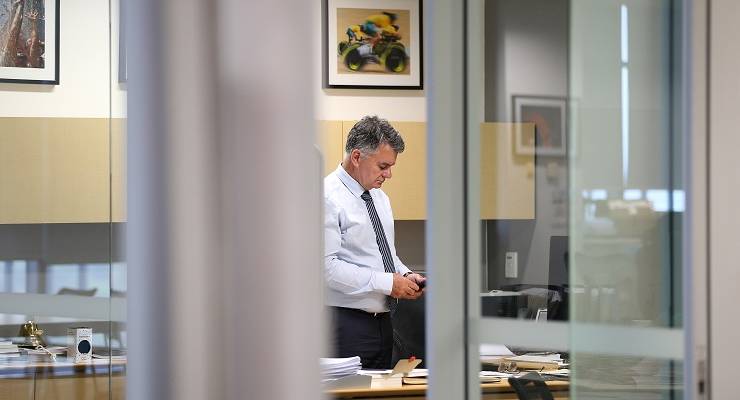
The end, when it came, was messy: a story leaked to the Nine newspapers that Australian Associated Press (AAP) was dead.
The newswire’s near-600 staff (500 full time, plus 100 contractors), scattered around Australia and overseas, found out in the worst way possible that time was up for the 85-year-old institution of Australian journalism.
Editor-in-chief Tony Gillies immediately set off on a series of flying visits around the Australian bureaus to provide whatever facts he could. “It’s a deplorable situation,” he told Inq, “a horrible scenario for journalism. But you can’t go on losing money.”
Allen Williams, managing director of regional media player Australian Community Media (ACM) which has a tiny 2.7% shareholding in AAP and therefore no seat on the board, was also taken off guard by the story that emerged at the beginning of last week.
“I would have thought they could have informed us first,” he told Inq. “But the real game at the table is between Nine and News.”
The two big players
Ultimately the fate of the AAP newswire, which provides quick, accurate and unbiased news reporting, was in the hands of the Nine and News Corporation which together hold 90% of AAP’s shares. Seven West Media and ACM make up the rest.
There are just two journalists on the board: chairman Campbell Reid, a News Corp veteran and one-time editor of Sydney’s Daily Telegraph, along with Nine’s James Chessell, group executive editor of Australian metro publishing, covering the SMH, The Age and the Financial Review. Other members are a mix of finance, accounting and digital media specialists.
AAP’s fate, it emerged, had been decided at a board meeting in January. Momentum had been building after Nine Entertainment’s merger with Fairfax in late 2018. Nine always said it would get rid of its regional titles because it saw them as uncommercial. It did that in July last year.
Inq understands this led Nine to question why it would continue to hold on to AAP, given it was no longer a dominant user of the service.
The decision to close AAP will make life suddenly more difficult for smaller outlets with few staff who have relied on the agency, for a fee, to provide straight-down-the-line reporting which they could not otherwise afford.
“I look at the 350 stories a day we’re putting out and I wonder who will provide them,” said Tony Gillies. The agency provides coverage on courts, sport and politics — as well as photography — that might otherwise not see the light of day.
Theories have emerged as to the motives of Nine and News in burying the independent news agency.
Rupert Murdoch’s News Corp is accused of seeking to deprive smaller competitors’ access to copy, thereby destroying any remaining diversity in Australian journalism.
The accusation against Nine is that with a culture perhaps more oriented to Married at First Sight, since the Nine Entertainment company absorbed the old Fairfax, it had no lingering sentimental attachment to the business of fair and honest reporting.
Nine and News contribute some $20 million to AAP as the dominant shareholders. They have the same shareholding at 44.5% each but, for historical reasons, News pitches in around 55% of shareholder funds.
Competitors such as the Daily Mail and The Guardian pay subscription fees of up to around $200,000, pegged to the level of service. Crikey and Inq take a news photography feed from AAP.
Those immediately affected by the decision disputed that there was anything sinister at play.
Gillies put the decision down to the fact that the AAP business model was no longer sustainable and that it was not realistic to expect Nine and News to keep plying AAP with funds as well as pay a subscription for AAP’s services.
The truth is somewhat more prosaic.
A bigger problem
The number of AAP’s clients has ebbed away over the years. Banks once subscribed to the AAP wire. Much of commercial radio now gets the scant news it needs via a Google search. Those that remain have been less able to afford the service due to their own finances.
AAP has attempted to subsidise its wire service with profit-making businesses. These included its press release distribution arm, Medianet, a service which, as with other parts of the news media, faces increased competition from other players and cheaper alternatives, including tech platforms.
No one believes in AAP more than AAP itself — yet when given the chance it could not save itself via a management buyout.
Inq understands that a private equity group ran the ruler over the news service but that any sale would have involved considerable shutdown costs.
AAP is bound by an unusual and complicated shareholder agreement that offers a glimpse into a media landscape of a bygone era.
According to one critical clause, neither News or Nine could walk away from the service without paying out the other five years worth of subscription funds — around $25 million for Fairfax (now Nine) and $40 million for News.
This put the two media rivals in a stalemate that was difficult to walk away from, sources said.
The question remains as to whether AAP’s death would have happened if Nine and Fairfax hadn’t merged.
Sources told Inq that the merger had certainly greased the wheels of a sale, if only because it was easier to get News and Nine in a room together, without the historic animosity of the two big newspaper rivals.
Inq has confirmed that Nine was not required to maintain its shareholding in AAP as part of undertakings under the Nine-Fairfax merger of 2018 overseen by the Australian Competition and Consumer Commission (ACCC). It’s not known if the ACCC considered the ramifications of Nine selling its regional newspapers — a move which Nine fully telegraphed at the time.
Can it still be saved?
Most chilling now is that there appears to be no prospect of a saviour coming to the rescue of the business, even though it made a profit of about $930,000 in 2018-19.
The newswire services was reliant on additional payments from its shareholders, mainly Nine and News. These reportedly jumped by almost $500,000 last financial year and came off the back of another year of job cuts.
There are reports that News is looking at setting up its own wire service and that AAP’s chief executive Bruce Davidson is examining the idea of setting up a business to supply horse racing content, puzzles and content moderation.
News media executives are canvassing other options and funding models. But it seems unlikely that the full spread of AAP coverage will be saved — unless a body with deep pockets comes to the rescue before the June 26 close down.
Former Sky News host and long-time business journalist Janine Perrett last week let off a salvo against the Judith Neilsen Institute (JNI), which set up shop in late 2018 with $100 million in philanthropic funds to further the cause of independent journalism in Australia.
“A pity that billionaire Judith Nelson [sic] couldn’t give some of that $100 million to AAP to save real journalism instead of setting up an indulgent and meaningless ‘Institute For Journalism’,” Perrett tweeted.
Asked if JNI had plans to intervene — for example by helping put together a financial rescue group — the institute’s executive director Mark Ryan told Inq:
“The closure of AAP is a sad day for the industry and for the country. We will watch developments over the coming weeks and months to see if there are things we could do to help address some of the issues raised and gaps caused by AAP’s closure.”
JNI was set up to “support and celebrate” quality journalism during a period of “historic transformation”. Its priorities include creating new opportunities for journalists; focusing on projects with the greatest impact; to be non-partisan; and to respect the principle of editorial independence.
To date it has provided support to News Corp’s The Australian for reporting on China. (The Australian‘s eminence grise, Paul Kelly, is a JNI board member.) The institute has also funded Nine to set up a Financial Review bureau in Indonesia and to hire two Indigenous reporters to the SMH/Age.
The ACCC has said it will monitor the impact on competition. But that may boil down to which players pick over the AAP carcass to pluck out the odd profit-making venture, such as its press release distribution business AAP Medianet.
The collapse of AAP is symptomatic of what has been happening to news agencies around the world.
According to Gillies, there are around 100 news agencies left. Eighty of those are government-owned. The others include the large international agencies Agence France Presse, Reuters and the Associated Press. Germany’s news wire, Deutsche Presse Agentur, operates with 179 large and small media shareholders. No entity can hold more than 1.5% of its total capital, limiting the influence of any single shareholder.
Beyond the immediate culture wars of who is to blame for AAP’s demise, it’s clear that the failure of the market to guarantee the survival of an unbiased news provider represents a further weakening of media independence in a market where partisan coverage and commentary is on the rise.
But what of Google and Facebook who have pilfered journalism for their own financial advantage with no regard for consequences?
The ACCC last year found that the value of the Australian newspaper market had fallen from $4.6 billion to $2.5 billion over the past decade, and is dwarfed by the size of Google and Facebook.
Media union head Marcus Strom said: “Where the market fails, the government must step in. But late last year, the government response to the problems clearly outlined by the ACCC was totally inadequate. If it had picked up on the recommendation by MEAA and a number of media organisations for a percentage of the revenue digital and social media platforms make from the sharing of expensive media content to be distributed through a public interest journalism fund, then perhaps the future of AAP might not look so grim today.”
Amidst the hand-wringing concern, the question “who cares?” is yet to be answered in any meaningful way. Certainly no wealthy progressives or centrists have stepped up. Will anyone put their money into a loss-making venture which has the social dividend of preserving public interest journalism?









So much for competition law when Nine and News own AAP. Media concentration and gutless regulatory enforcement of competitive capitalism will be the death of democracy (and free markets).
I am sure the current government will be happy. They hate facts, transparency and being held accountable. They prefer media to be used for marketing purpose only.
Without AAP, The Australian will look and read even more like The Tele.
Further proof that Rupert Murdoch has the psyche of a publisher, not a journalist.
He may appreciate quality in journalism but it’s a luxury on which his business is not based & does not support.
There goes the neighbourhood – even the ABC is going tabloid. Insiders, inoculated with Speers from Rupert’s Muppet Show, Viellaris back on there again yesterday.
Lowering the ABC to Limited News status – who cares if it eventually goes under?